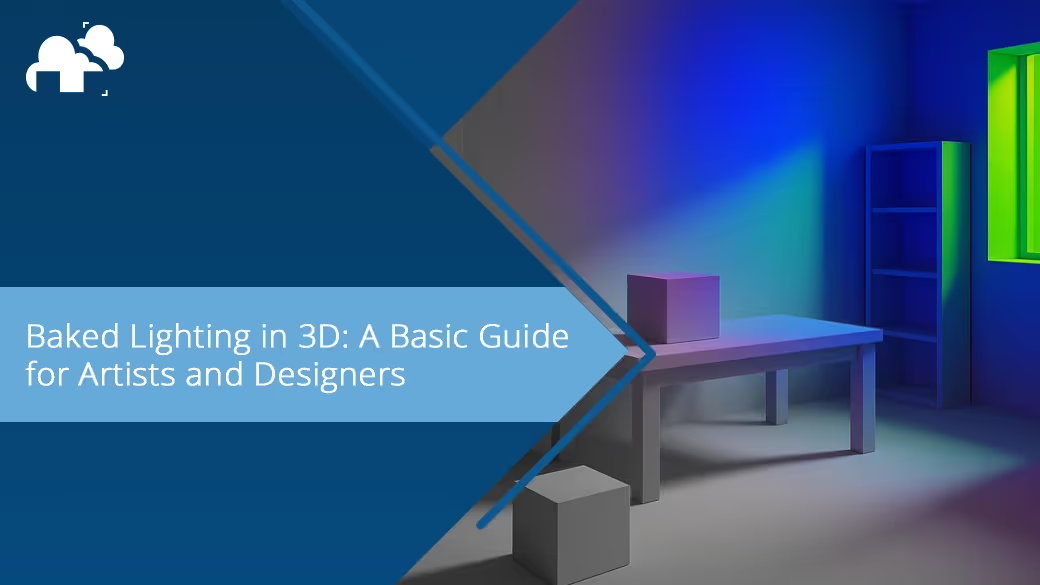
In the context of modern 3D production pipelines, baked lighting continues to hold practical relevance. While real-time ray tracing and path tracing are increasingly common, baked lighting remains an efficient and reliable method for achieving high-quality visuals with optimized performance. Whether applied in architectural visualization, virtual reality, game development, or stylized animation, baked lighting enables creators to deliver detailed and atmospheric scenes without the computational burden of fully dynamic lighting systems.
Baked lighting refers to the precomputation of lighting data, including direct and indirect illumination, shadows, and ambient occlusion, which is then stored in texture maps, also commonly referred to as lightmaps.
These textures are applied to objects within the scene, eliminating the need to compute lighting during rendering or runtime. This approach is particularly effective for static scenes where lighting conditions remain constant. It allows for the efficient reproduction of realistic lighting effects while significantly reducing computational load.
Lightmaps are specialized textures that encode how light interacts with a surface. Each texel in the lightmap corresponds to a point on the model and contains lighting information such as intensity and color.
Lightmap data requires a unique UV layout separate from that used for color or detail textures. These UVs must be non-overlapping to ensure accurate lighting representation and prevent artifacts such as light bleeding.
Baked lighting systems compute not only direct lighting but also indirect illumination, a light that reflects off surfaces and contributes to the overall lighting environment. This adds realism and depth to the scene, particularly in indoor or partially enclosed environments.
Ambient occlusion simulates the attenuation of ambient light in corners and recesses. Including ambient occlusion in the baking process enhances the perception of form and spatial relationships, especially when fine geometry is present.
Baked lighting is essential in scenarios where real-time performance is critical. It is frequently used in game development, VR applications, and interactive visualizations to maintain frame rates without compromising visual quality.
The technique supports detailed lighting effects, including soft shadows and color bleeding, which may be computationally expensive or impractical with real-time lighting solutions.
In pre-rendered workflows, baking lighting reduces the time required for final image or animation generation. This is particularly advantageous in long-format animations or when using online render farms.
Common causes of light leaks or artifacts include overlapping UV shells, insufficient padding, or errors in UV layout. These should be addressed during the unwrapping and packing stages of the lightmap UV process. Another possible cause could be the compression quality, in which some maps start to get artifacts the lower the quality.
Proper dilation ensures that texel information extends slightly beyond the UV island borders. This prevents visual seams caused by mipmapping or texture filtering during rendering.
Efficient UV packing improves texel density and ensures uniform lighting resolution across the scene. Avoid underutilized texture space and disproportionate shell sizes to maintain consistency.
Any modifications to lighting conditions, object positions, or scene geometry necessitate rebaking. Planning for incremental updates can mitigate excessive processing times during late-stage revisions.
In many projects, it is practical to bake global illumination while enabling real-time shadow casting for dynamic objects. This hybrid method provides visual depth without incurring excessive runtime costs.
Light probes and reflection captures transfer baked lighting data to dynamic or moving objects. This technique ensures cohesion between static and dynamic elements in the scene.
Baked lighting is also effective in stylized workflows. Artists may bake lighting directly into textures to unify the look of assets, particularly in projects that favor illustrative or painterly aesthetics.
By offloading lighting calculations to precomputed textures, baked lighting decreases GPU usage and improves application responsiveness. This is particularly important in resource-constrained environments such as mobile or web platforms.
Well-managed lightmap textures reduce shader complexity and draw calls, contributing to a leaner and more manageable project file.
Prebaked lighting accelerates rendering by eliminating the need for dynamic light evaluations, which is advantageous when rendering multiple frames in animation workflows or distributed rendering environments.
While baked lighting is advantageous in many situations, it is not suitable for all scenarios. Highly dynamic environments, real-time interactive lighting, and procedural lighting setups are better served by real-time or ray-traced solutions. Furthermore, frequent adjustments to lighting or geometry can lead to inefficiencies, as each change may require a complete rebake. Projects that demand rapid iteration or feature complex lighting behavior should evaluate alternatives accordingly.
Baked lighting remains a practical and efficient solution for producing high-quality visuals in 3D environments. While not universally applicable, it is a valuable tool in the 3D artist’s toolkit, particularly when used as part of a hybrid lighting strategy. By understanding its principles and limitations, artists can leverage baked lighting to enhance realism, guide storytelling, and optimize their scenes for various rendering contexts.